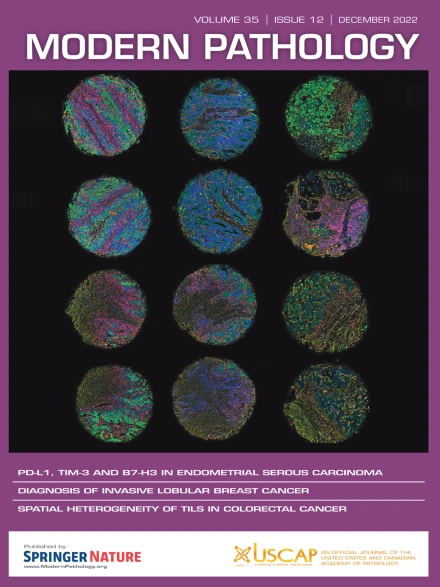Population-Specific Immunogenomic Alterations in Gallbladder Cancer and Prognostic Significance
IF 7.1
1区 医学
Q1 PATHOLOGY
引用次数: 0
Abstract
Gallbladder carcinoma is a deadly disease with a poor prognosis, and recent clinical data suggest only a modest benefit of PD1/PDL1 inhibitors in this disease. Optimizing immunotherapeutic approaches will require a detailed understanding of the immunogenomic landscape of this disease worldwide. We combined targeted next-generation sequencing and immunohistochemistry to create detailed immunogenomic landscapes from 2 cohorts of gallbladder cancer cases from the United States (n = 60) and Chile (n = 62). Mutations in TP53, SMAD4, KRAS, PIK3CA, ARID2, ARID1A, ATM, FBXW7, ERBB2, and NF1 were found in both the US and Chilean primary cohorts, as well as amplifications in ERBB2, CCNE1, MDM2/CDK4, and CCND1. Despite similar mutation profiles, the immune profiles were distinct, with the Latin American cohort having higher densities of biomarkers associated with CD4+ T cells and PD-1 but lower densities of CD68+ macrophages compared with the North American cohort. Clustering and correlation analyses suggest novel immune subgroups and clinical associations independently of any specific mutations. Additionally, supported by multiplexed single-cell imaging technology, we identified low CD4 and high V-domain Ig suppressor of T cell activation as a candidate biomarker pair of poor outcomes. In summary, our findings highlight the importance of sensitivity to geographic location when considering therapeutic developments and pave a path for further immune investigations of this understudied disease.
胆囊癌人群特异性免疫基因组改变及其预后意义。
胆囊癌是一种预后不良的致命疾病,最近的临床数据表明,在这种疾病中,PD1/PDL1抑制剂只有适度的益处。优化免疫治疗方法需要对全球范围内这种疾病的免疫基因组学景观有详细的了解。我们结合了靶向下一代测序和免疫组织化学,从来自美国(n=60)和智利(n=62)的两组胆囊癌病例中创建了详细的免疫基因组图谱。在美国和智利的主要队列中均发现了TP53、SMAD4、KRAS、PIK3CA、ARID2、ARID1A、ATM、FBXW7、ERBB2和NF1的突变,以及ERBB2、CCNE1、MDM2/CDK4和CCND1的扩增。尽管有相似的突变谱,但免疫谱是不同的,与北美队列相比,拉丁美洲队列具有更高密度的与CD4+ T细胞和PD-1相关的生物标志物,但CD68+巨噬细胞的密度较低。聚类和相关分析提示新的免疫亚群和独立于任何特定突变的临床关联。此外,在多路单细胞成像技术的支持下,我们确定了低CD4和高VISTA作为不良预后的候选生物标志物对。总之,我们的研究结果强调了在考虑治疗发展时对地理位置敏感性的重要性,并为进一步研究这种未充分研究的疾病铺平了道路。
本文章由计算机程序翻译,如有差异,请以英文原文为准。
求助全文
约1分钟内获得全文
求助全文
来源期刊

Modern Pathology
医学-病理学
CiteScore
14.30
自引率
2.70%
发文量
174
审稿时长
18 days
期刊介绍:
Modern Pathology, an international journal under the ownership of The United States & Canadian Academy of Pathology (USCAP), serves as an authoritative platform for publishing top-tier clinical and translational research studies in pathology.
Original manuscripts are the primary focus of Modern Pathology, complemented by impactful editorials, reviews, and practice guidelines covering all facets of precision diagnostics in human pathology. The journal's scope includes advancements in molecular diagnostics and genomic classifications of diseases, breakthroughs in immune-oncology, computational science, applied bioinformatics, and digital pathology.
 求助内容:
求助内容: 应助结果提醒方式:
应助结果提醒方式:


